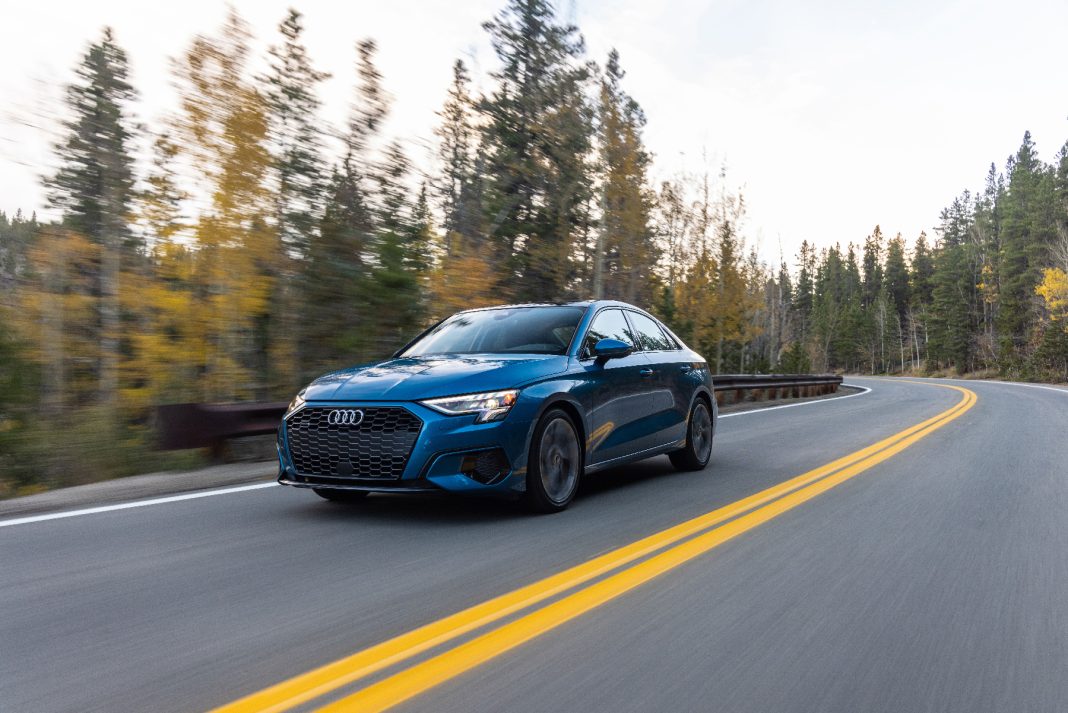By Eric Peters
2023 Audi A3
It’s an interesting fact that while small sedans have largely disappeared from the general market, you can still find a number of them in the luxury car market — including subcompact models like Audi’s A3 sedan.
It’s a really small car — about the same size as a Hyundai Accent, which is pretty much the smallest sedan you can buy. This pint-size Audi is nearly as economical to drive as the Accent, too, rating 28 mpg in city driving and 38 mpg on the highway. (The Accent carries an EPA rating of 33 city, 41 highway.)
But the A3 isn’t an economy car. It’s an economical luxury car.
And that may account for people wanting to buy it.
What It Is
The A3 is Audi’s smallest sedan, and a much smaller sedan than non-luxury-brand compacts such as the Honda Civic sedan and the Toyota Corolla sedan, both of which are nearly a foot longer.
It’s only 176.4 inches long — just barely longer than a Hyundai Accent sedan, which is the smallest four-door sedan you can still buy that isn’t a luxury-brand sedan.
It comes in two trims: Premium ($34,900) and Premium Plus ($38,500). Both trims come standard with a turbocharged 2.0-liter engine paired with a mild-hybrid system that cycles the engine off as often as possible (hence the economy car gas mileage) and a seven-speed automatic transmission.
Quattro all-wheel drive is available optionally.
What’s New
LED headlights are now standard in both trims, and wireless charging has been added to the Convenience Package. Last year’s Prestige trim has been dropped.
What’s Good
Economy car mileage in a luxury car package.
Roomier back seat and larger trunk than rival small luxury cars offer.
Fits easily where it’s tight for larger cars.
What’s Not So Good
Generic exterior styling.
The upgrade (15-speaker, 680-watt) Bang & Olufsen 3D audio system requires buying the Premium Plus trim and then buying the $2,250 Technology Package, pushing this “entry-level” Audi’s MSRP well over $40,000.
Under The Hood
Economy cars are economical because their engines aren’t powerful. The A3’s 2.0-liter engine (standard in both trims) is powerful and economical. It makes 201 horsepower and uses only a little more gas than the 120-horsepower engine that just barely powers the only slightly more economical Hyundai Accent.
But it’s more than just power that makes the difference.
This Audi uses very little gas because its engine is frequently not using any. The A3 features a mild hybrid system that automatically shuts down the engine when engine power isn’t needed, as when the car isn’t moving or when it’s decelerating/coasting. A belt-driven starter is used to quickly get the engine running again whenever its power is needed, without the driver feeling (or hearing) it.
On The Road
One of the main reasons to buy a small car is because it is a small car.
Small cars are easier cars to drive in traffic because they can exploit briefly open windows in traffic that are closed to larger cars. It is easier to maneuver around something blocking the way when you are driving something that can sneak around it; To fit into a tight curbside parking spot you’d otherwise have to pass by, if you were driving a larger car.
The main reason not to buy a small car is, usually, the small car ride. That “small car” feeling you get when everything around you, just about, is bigger. That latter is something Audi can’t do much about without making the A3 bigger — and then it wouldn’t be an A3 anymore.
The former is something Audi did something about that.
In part by adding gravitas — weight.
A small car like the Hyundai Accent feels like what it is because it doesn’t weigh much — just 2,670 pounds. The almost-the-same-size A3 weighs 3,329 pounds (3,494 pounds for the Quattro model) and those additional pounds translate into heft, the quality that makes even a smaller car feel like a larger car.
Of course, weight isn’t the only difference. The A3 has a four-link rear suspension with aluminum rather than stamped steel pieces; the Accent has a simpler torsion beam rear suspension.
You’ll feel the difference every time the road dips, also when you push down on the accelerator. The A3 (SET ITAL) accelerates. (END ITAL) An economy car like the Accent eventually gets going.
At The Curb
The exterior of the A3 is blandly attractive.
It’s the inside that will turn your head — or, rather, the space inside, given how small this car is on the outside.
You’d expect the back seats in such a small car to be almost unusable. And they are — in rival subcompact luxury cars like the Mercedes A-Class, which offers a scanty 33.9 inches of rear-seat legroom versus a surprisingly generous 35.2 inches in the Audi.
The trunk, on the other hand, is tight — just 10.9 cubic feet of capacity.
The Rest
As Audi’s least-expensive car, the A3, is nominally an “entry-level” car. The designation has lost much of its former meaning, though, because current “entry-level” luxury cars such as the A3 come standard with features and amenities you used to have to buy a much more expensive car to get. These include three-zone climate control, a configurable LCD instrument cluster (with another larger LCD screen off to its right that displays Google Earth-style GPS map overlays), leather seats and a panorama sunroof.
The Bottom Line
It’s economy-size, and as economical to drive as an economy car. But the A3’s an economy car like Hulk Hogan is petite.
View the Audi A3 this week.
Eric’s latest book, “Doomed: Good Cars Gone Wrong!” will be available soon. To find out more about Eric and read his past columns, please visit the Creators Syndicate webpage at www.creators.com.
COPYRIGHT 2022 CREATORS.COM




